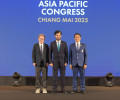AUTO: The Drive for Fuel Efficiency

Great strides have been made in the development of electric and fuel cell-powered vehicles, and the assumption is that they can provide the answer to the unsustainable use of fossil-based fuels. Yet these technologies are still far from mature, and the growth in vehicles led by emerging economies such as China and India will still heavily involve conventional rather than electric technology.
According to Peter Frise, Professor of Mechanical and Automotive Engineering at the University of Windsor and CEO and Scientific Director at Canadian research network AUTO21, the energy density of present-day batteries is “only about 10 per cent” that of any fossil fuel. He says that despite extensive research and development efforts on new batteries, that statistic has not changed markedly over the past few years. Doctor Chris Bannister of the Powertrain and Vehicle Research Centre at the University of Bath agrees, predicting that fossil-based fuels “will continue to be the most significant contributor for the foreseeable future”.
However Sheila Watson, Director of Environment and Research at the FIA Foundation and Executive Secretary of the Global Fuel Economy Initiative (GFEI), believes that a focus on improving fuel economy with readily available technologies will be vital. “Fuel efficiency is not necessarily seen as a very sexy issue, it’s not as exciting as electric vehicles or new forms of propulsion, but it’s important to stay focused on it,” she says.
In both developed and emerging markets, Frise says that the main technological focus for improving fuel economy is centred on efforts to reduce vehicle weight through the use of lightweight, “high-strength materials, downsized powertrains and other components and systems”.
According to Christophe Aufrère, Vice-President of Technology Strategy at Faurecia “The best way to cut CO2 emissions from vehicles is to make them drastically lighter,” he says. “The second best way is to recover heat lost in the exhaust system. Faurecia is developing technologies that can recover part of this available thermal energy to help reduce fuel consumption by up to seven per cent. Once captured, the energy can be used to heat the cabin or accelerate engine or gearbox-warming time.”
Looking ahead, there is a pressing need for global coordination on fuel economy to ensure that the gains that must be made – and are achievable with available technologies – are put in place particularly in developing countries. Key targets developed by the GFEI – such as halving the amount of fuel used by all new cars globally by 2030 – have been adopted by the United Nations in discussions over the new global development goals to cover the next 15 years. This agenda is also part of the UN’s climate change negotiations.
As Watson says: “Such processes promise to have a real impact in the countries facing the biggest challenges on fuel economy, supporting the development of policies and strategies to make dramatic reductions in fuel use.”

 Facebook
Facebook Twitter
Twitter






